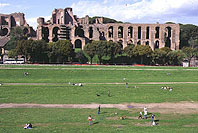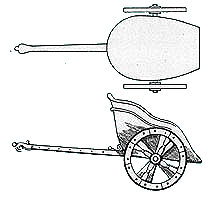Circus Maximus and Baths of Caracalla
Circus Maximus
 Today an enormous quiet field (6 football fields in length), yesterday reverberating to the roar of the madding crowds exhorting the horses they wagered on, and the screams of charioteers urging their steeds ahead.
Today an enormous quiet field (6 football fields in length), yesterday reverberating to the roar of the madding crowds exhorting the horses they wagered on, and the screams of charioteers urging their steeds ahead.
The movie Ben Hur illustrates exactly how these chariot races functioned.
250,000 people were maximum capacity except for the Emperor's private stand, which was an extension of this own mansion on the Palatine Hill.
Magistrates ruled the races at either end, and the central "spina" (spine) was crowned with obelisks and markers to show how many laps the chariots had run. The horses were famous all over the Roman world and betting was fierce. Each team had its own colors.
At the Tiber River end, just behind the present Church of St. Maria in Cosmedin, were the stables which housed not only these million-dollar horses, but also the Temple of the pagan god Mithras where the charioteers went to pray before a big race.
| Circus Maximus History  8C BC. Rome's first recorded games were horse races organized here by city founder Romulus. He took advantage of this event to stage the "Rape of the Sabine Women", when the lonely Roman men invited their neighbors from the Sabine Hills, but killed all the male visitors and married the widows. 42 BC. Julius Caesar's murder interrupted his plan to modernize this stadium, which was completed in its permanent form by Emperor Augustus. 64 AD. The stands being of wood, this was where the great fire of Nero broke out. |
Between Via dei Cerchi and Via Circo Massimo (Map I 9)